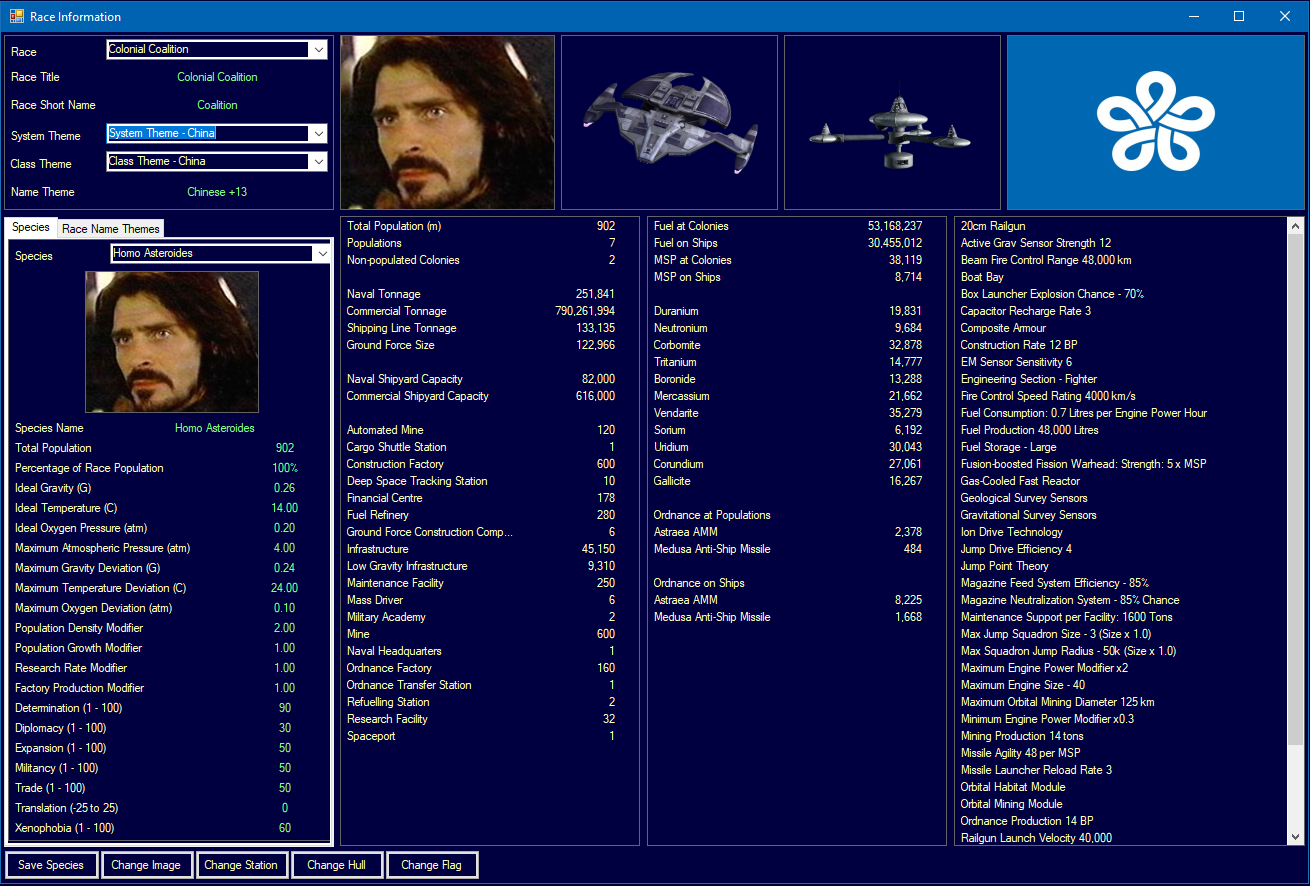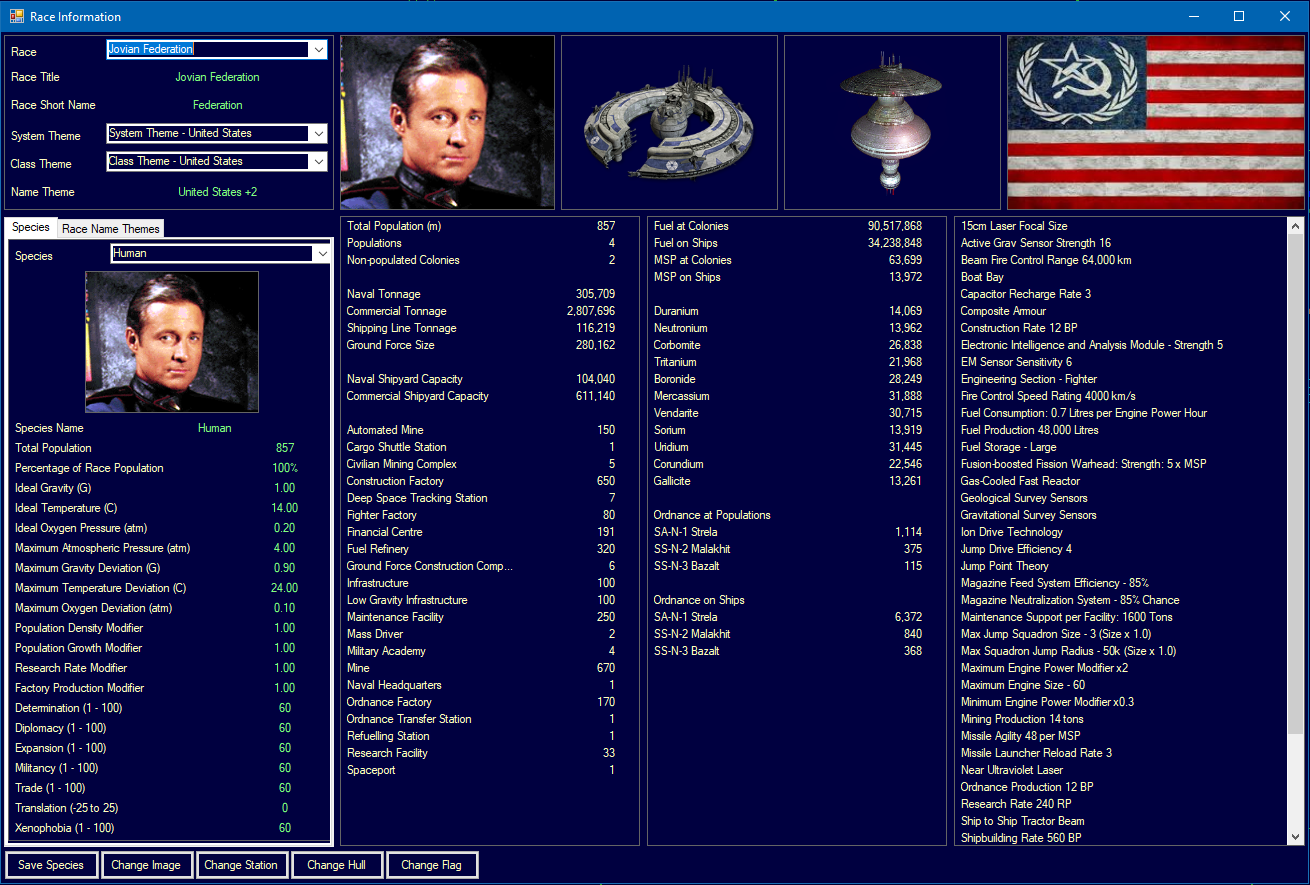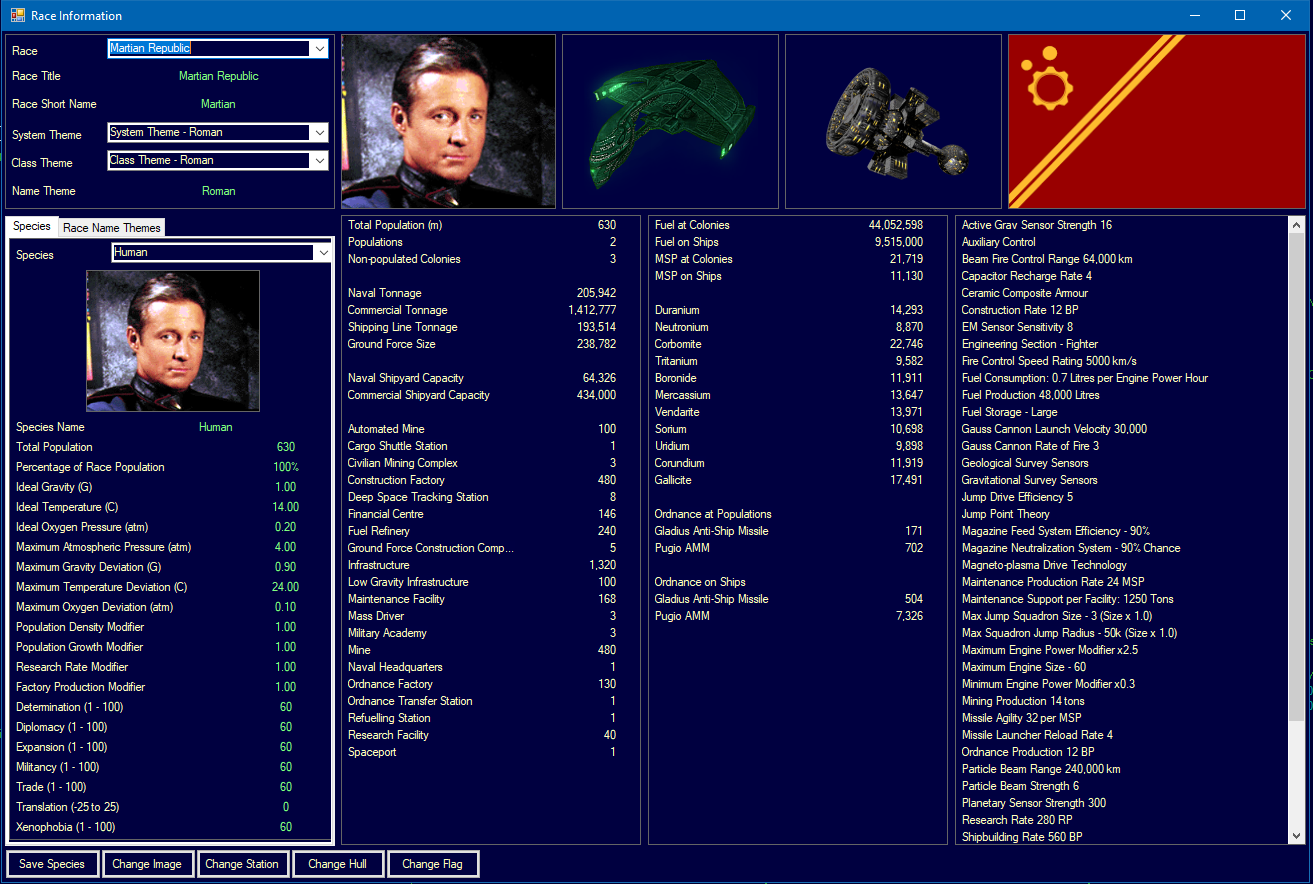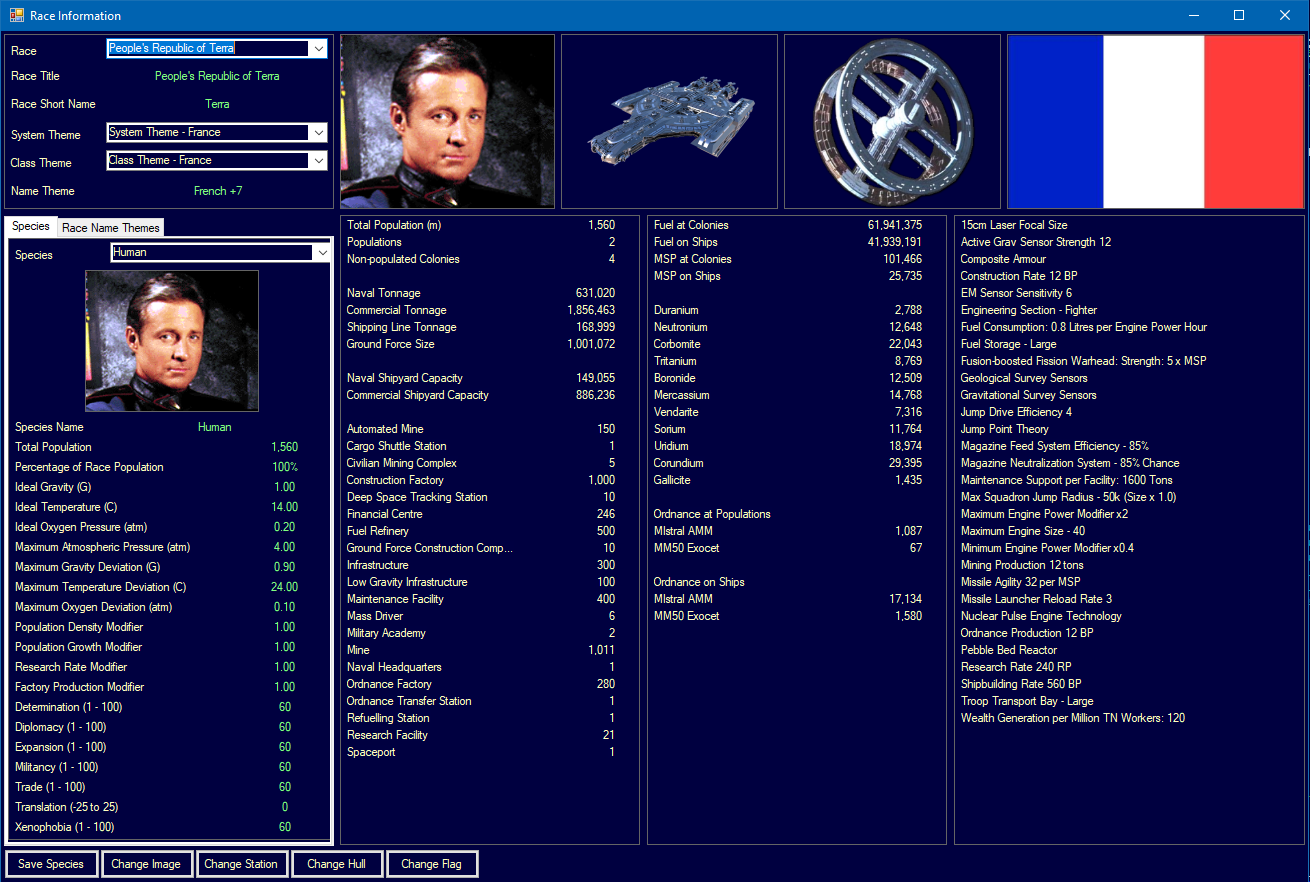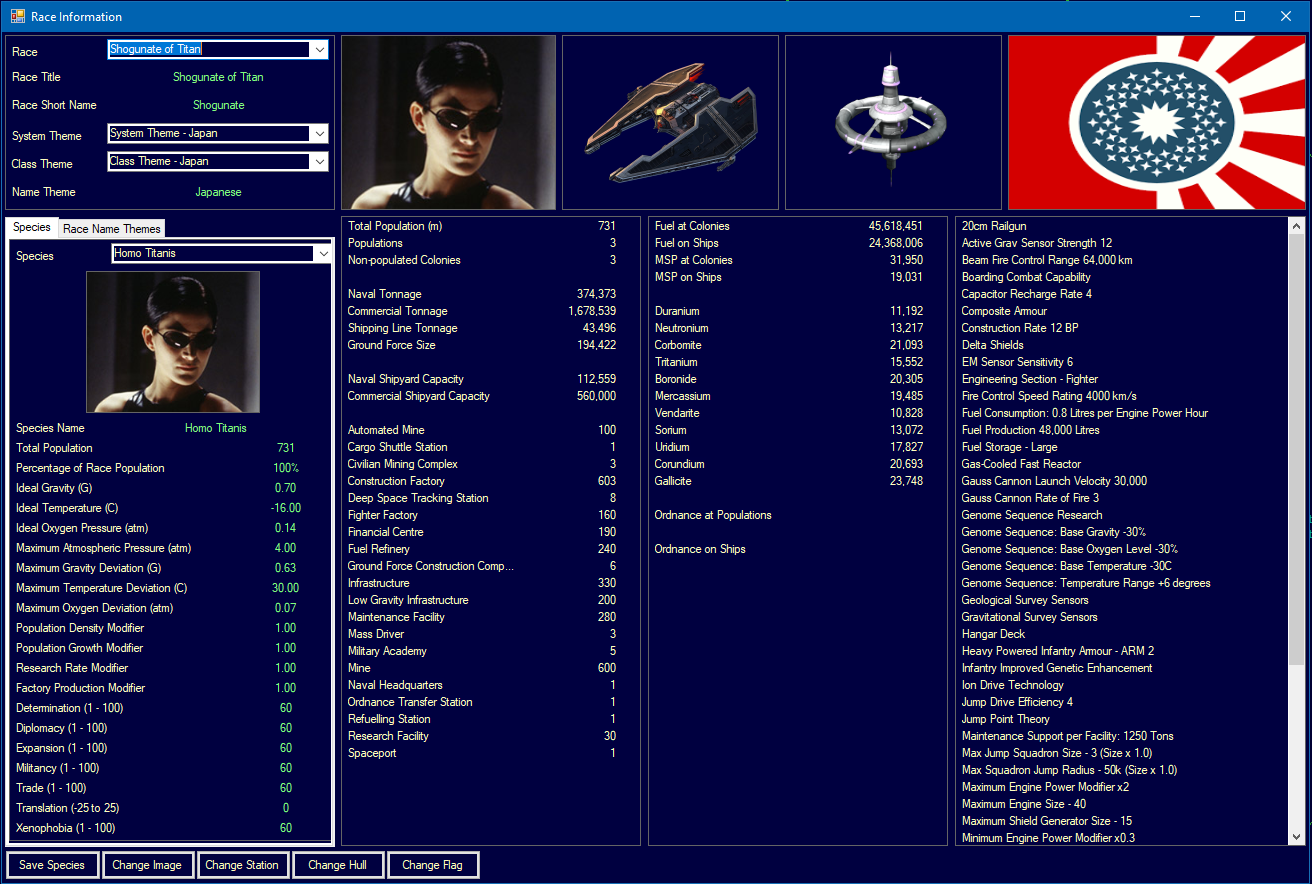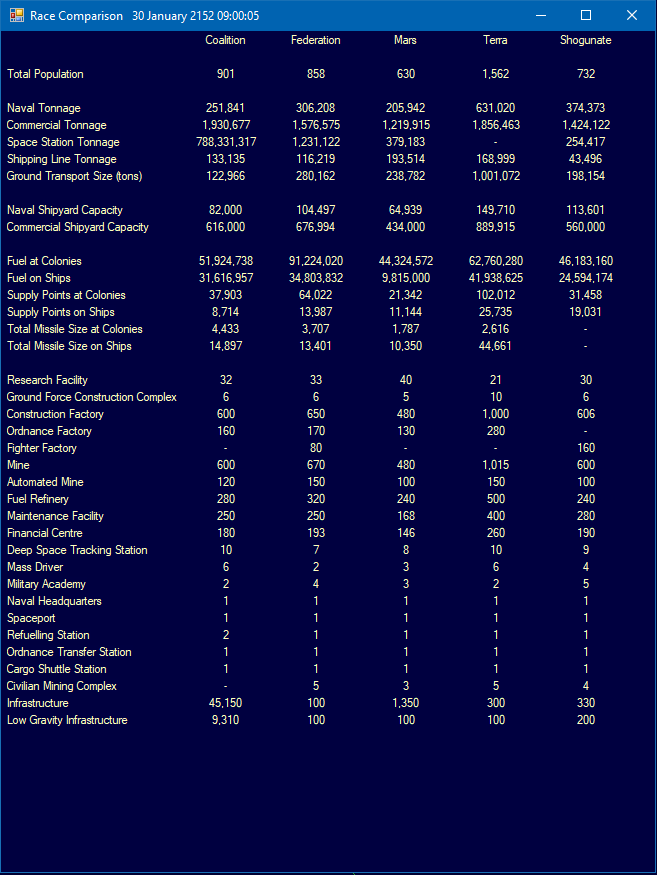2150With the dawn of the Interstellar Age, the Solarian states began a period of relatively low tensions. Prior to the Martian revelations, there had been a reluctance to create new colonies, particularly outside the recognised spheres of influence. All the powers had been aware that resources were running out and that conflict was probably inevitable, but most were wary of being the first to make a move and therefore be seen as the aggressor by the others. The People’s Republic was the exception and had fully intended to secure the unclaimed resources as soon as its forces were ready. After the revelations, with the potential for exploring beyond Sol, there was little appetite for a clash that would that weaken the participants relative to the uninvolved states at such a critical time. The Martian plan was having the desired effect.
The Colonial Coalition and the People’s Republic both established mining colonies on the comets Swift-Tuttle and Wild. Both powers had Corundium deposits of less than 50,000 tons, so the 140,000 tons of accessibility 0.5 Corundium on Swift-Tuttle was very appealing, especially when combined with 120,000 tons of 0.8 Duranium and smaller deposits of Boronide and Uridium. Wild had six mineral deposits between ten and fifty thousand tons, all of which were at reasonable accessibility. The People’s Republic was particularly interested in the Gallicite as the deposit on Terra was only 0.5 accessibility. The Coalition also created new populated colonies on the asteroids Abastumani and Julia.
Mars ended its isolation by establishing a colony on Mercury. The Martian Republic was limited by its population and could only expand its industry as that population grew. The settlement on Mercury was created in an effort to speed up that growth and create a larger manufacturing sector. In addition, the Republic established a mining colony on the comet Van Biesbroeck to compensate for the shrinking deposits of Tritanium, Uridium and Gallicite on Mars. The Shogunate also established a colony on Van Biesbroeck, although for the Neutronium, Tritanium and Uridium as Titan was blessed with two hundred and forty thousand tons of accessibility 1.0 Gallicite, and created a small settlement on Iapetus. The Jovian Federation was the only government not to create a new colony, although civilian mining colonies from the Federation and the Shogunate were established on the dwarf planet Haumea.
The new openness with the Sol system also promoted the creation of civilian shipping lines. For Mars, the new shipping line concentrated on growing the population of Mercury, which reached one point six million by the end of 2150. For the Jovian Federation and the Colonial Coalition, the civilian ships mainly conducted trade between the existing colonies. Ouellet Interplanetary Transport, the shipping line of the People’s Republic of Terra, moved colonists from Earth to the Moon and conducted trade between the two populations. The least active civilian shipping line was that of the Shogunate, which made only a couple of trips to Iapetus before the end of the year. Iapetus was a low gravity world, even for homo titanis, so the Shogunate had to build low gravity infrastructure for the colony rather than it being created through trade.
Following its revelation of the existence of jump point theory to the other Solarian states, the Martian Republic began research into jump drive technologies and gravitational survey sensors. The other powers began their own research into jump point theory, based on the information provided by Mars. In most cases, the number of available research facilities was greater than the administrative abilities of the top propulsion scientist, so each nation simultaneously conducted research on several other projects.
Every nation constructed new ships during 2150. The Coalition built a dozen Nemesis class fast attack craft and four Kythera class freighters. The Jovian Federation constructed six River class Patrol Vessels, taking the total for the class to eighteen, two 500-ton Molniya class corvettes, an Iwo Jima class troop transport and two Liberty class freighters. The Martian Republic and the People’s Republic of Terra built two and three freighters respectively, while the Shogunate of Titan constructed three freighters and seven Reisen class Strikefighters.
2151By the first week of February 2151, every Solarian state had researched jump point theory. The Jovian Federation and the People’s Republic made the breakthrough in mid-January, followed by the Colonial Coalition at the end of the month and the Shogunate on February 6th. While the Martian Republic had researched all the prerequisite technology for a jump drive early in the year, the Senate decided to improve the basic level of efficiency before Martian scientists developed the first functional drive.
The system-wide research efforts finally translated into action on June 26th 2151 when the Martian Republic laid down the first Belisarius class Gravitational Survey Vessel. The design was a conversion of the Angelus class geological survey vessel and involved replacing the armament and armour with the Valerian-Sollemnis Drive Systems VSD-9000M Jump Drive. The Belisarius was a capable ship with four survey sensors plus great endurance and range. However, given its size and cost the first two ships would not be available until May 2153. The Senate considered ordering a refit of one of the two Angelus class ships to speed up deployment, but decided against the idea as it would significantly impact future geological survey capability.
Belisarius class Gravitational Survey Vessel 9,000 tons 231 Crew 1,279.7 BP TCS 180 TH 720 EM 0
4001 km/s JR 3-50 Armour 1-38 Shields 0-0 HTK 63 Sensors 8/8/4/0 DCR 12 PPV 0
Maint Life 6.05 Years MSP 1,066 AFR 54% IFR 0.7% 1YR 50 5YR 749 Max Repair 158.2 MSP
Trierarch Control Rating 1 BRG
Intended Deployment Time: 60 months Morale Check Required
Valerian-Sollemnis Drive Systems VSD-9000M Jump Drive Max Ship Size 9000 tons Dist 50k km Squadron 3
Marcellus-Gaius MG-360E Magneto-plasma Drive (2) Power 720 Fuel Use 19.69% Signature 360 Exp 7%
Fuel Capacity 1,200,000 Litres Range 121.9 billion km (352 days at full power)
Victricius Sensor Systems VSS-50 Active Search Sensor (1) GPS 4800 Range 51.3m km Resolution 100
S8 Thermal Sensor (1) Sensitivity 8 Detect Sig Strength 1000: 22.4m km
S8 Passive EM Sensor (1) Sensitivity 8 Detect Sig Strength 1000: 22.4m km
Gravitational Survey Sensors (4) 4 Survey Points Per Hour
The first Martian troop transport, the Draco, was launched a few days after the two Belisarius class ships were laid down. Two Cohortes and one Ala of Legio V were transported to Mercury by the Draco to provide protection for the growing Martian colony. At this point, the population was three point two million and operated thirty-eight financial centres. A second Draco was completed before the end of the year, along with two Cetus class freighters and two Delphinus class colony ships.
In mid-August the Jovian Federation completed research into gravitational survey sensors. Rather than wait for the first Jovian jump drive, the Federation President and his senior military advisors decided to proceed with a non-jump-capable survey ship. The Alexei Leonov class gravitational survey vessel was almost identical to the Armstrong class geological survey vessel, which allowed the Spencer Dockyard orbital shipyard that built the Armstrongs to be retooled within a few months. Alexei Leonov and her sister ship John Glenn were laid down on November 17th. (Editor Note: It is worth noting that in Russian ships may be referred to as he, she or it, depending on the name of the ship. This is due to grammar rules that do not exist in English. As this report is in English, the female pronoun will be used throughout to avoid confusion).
As the Leonov class did not have a jump drive, the Jovian Federation planned to construct small space stations that would be towed to jump points, once discovered, to allow the Leonovs and Armstrongs to transit, along with River class patrol vessels and Molniya class corvettes if required. Once more efficient drive technology became available, the survey ships would be refitted with their own drives.
Alexei Leonov class Gravitational Survey Vessel 4,200 tons 99 Crew 660.7 BP TCS 84 TH 252 EM 0
3000 km/s Armour 1-23 Shields 0-0 HTK 29 Sensors 18/18/3/0 DCR 5 PPV 0
Maint Life 7.47 Years MSP 491 AFR 28% IFR 0.4% 1YR 15 5YR 232 Max Repair 100 MSP
Commander Control Rating 1 BRG
Intended Deployment Time: 60 months Morale Check Required
NPO Energomash RD-250FE Fuel Efficient Ion Drive (1) Power 252 Fuel Use 16.57% Signature 252
Fuel Capacity 665,000 Litres Range 172 billion km (663 days at full power)
SPS-16 Active Sensor (1) GPS 4800 Range 44.4m km Resolution 100
SAR-15 Thermal Sensor (1) Sensitivity 18 Detect Sig Strength 1000: 33.5m km
SQR-14 Passive EM Sensor (1) Sensitivity 18 Detect Sig Strength 1000: 33.5m km
Gravitational Survey Sensors (3) 3 Survey Points Per Hour
As the Alexei Leonov class would not be available until the end of 2152, the Federation decided to use the small craft factories that produced the Molniya class corvettes to produce a similar-sized survey vessel, again without a jump drive. This was an interim design and not intended for long-term use. The Newton class Gravitational Survey Craft was slow and equipped with only a single sensor. Even so, it had reasonable endurance and would provide a limited survey capability while the Federation waited for the Leonovs. The first Newton was built on November 1st 2151, making it the first Solarian craft to conduct gravitational survey operations. A second craft was launched on December 19th.
Newton class Gravitational Survey Craft 500 tons 13 Crew 124.8 BP TCS 10 TH 18 EM 0
1803 km/s Armour 1-5 Shields 0-0 HTK 3 Sensors 0/0/1/0 DCR 0 PPV 0
Maint Life 1.44 Years MSP 15 AFR 20% IFR 0.3% 1YR 8 5YR 120 Max Repair 100 MSP
Lieutenant Commander Control Rating 1
Intended Deployment Time: 15 months Morale Check Required
NPO Energomash RD-18E Small Craft Drive (1) Power 18 Fuel Use 76.25% Signature 18 Explosion 7%
Fuel Capacity 74,000 Litres Range 35 billion km (224 days at full power)
Gravitational Survey Sensors (1) 1 Survey Points Per Hour
With the completion of research into the basic jump drive technologies, the Jovian Federation was able to design and research a crude military jump drive and mount it on a space station. Two Gateway stations were constructed by the end of 2151 and remained in orbit of Ganymede while the Newtons searched for the first jump point. The two Jovian Apache class Tugs stood ready to move the Gateways as required.
Gateway class Space Station 1,350 tons 53 Crew 124.5 BP TCS 27 TH 0 EM 0
1 km/s JR 3-50 No Armour Shields 0-0 HTK 9 Sensors 6/6/0/0 DCR 0 PPV 0
MSP 0 AFR 271% IFR 3.8% Max Repair 60 MSP
Commander Control Rating 1 BRG
Intended Deployment Time: 3 months
Maximov-Voronov Drive Systems MV-42 Jump Drive Max Ship Size 4200 tons Distance 50k km Squad Size 3
SPN-8 Navigation Sensor (1) GPS 1600 Range 25.7m km Resolution 100
SQR-9 Passive EM Sensor (1) Sensitivity 6 Detect Sig Strength 1000: 19.4m km
SAR-10 Thermal Sensor (1) Sensitivity 6 Detect Sig Strength 1000: 19.4m km
In December, the Federation completed research into the Electronic Intelligence and Analysis Module, or ELINT module, which would allow intelligence gathering on the populations and active emissions of the other Solarian powers. The module was incorporated into a new design, the Vishnya class Intelligence Ship. The class was small and therefore hard to detect and the ELINT module utilised a passive array. The Vishnya was intended to operate for extended periods near foreign populations or stationary military forces. The design emphasised endurance and discretion, so it did not have the speed to shadow foreign fleets on manoeuvres. Retooling of the Kamenev Shipbuilding Company shipyard was expected to be completed by February 2152, at which point four Vishnya would be laid down.
Vishnya class Intelligence Ship 1,000 tons 25 Crew 159.2 BP TCS 20 TH 36 EM 0
1800 km/s Armour 1-8 Shields 0-0 HTK 9 Sensors 6/0/0/0 DCR 1 PPV 0
Maint Life 6.26 Years MSP 99 AFR 8% IFR 0.1% 1YR 4 5YR 65 Max Repair 100 MSP
Lieutenant Commander Control Rating 1
Intended Deployment Time: 48 months Morale Check Required
NPO Energomash RD-36E Small Craft Drive (1) Power 36 Fuel Use 53.92% Signature 36 Explosion 7%
Fuel Capacity 54,000 Litres Range 18 billion km (115 days at full power)
SAR-10 Thermal Sensor (1) Sensitivity 6 Detect Sig Strength 1000: 19.4m km
ELINT Module (1) Sensitivity 5 Detect Sig Strength 1000: 17.7m km
In addition to the ships mentioned previously, in 2151 the Jovian Federation constructed Frunze, the seventh Kirov class battlecruiser, a Burevestnik class orbital weapon platform armed with eight quad laser turrets, four Molniya class corvettes, four Liberty class freighters, two Mayflower class colony ship and an Iwo Jima class troop transport.
The Shogunate of Titan followed a development strategy that was a hybrid of the Martian and Jovian approaches. Shogun Tokugawa ordered his Daimyo to wait for improved efficiency tech before designing the first gravitational survey ship, which would mean a delay until mid-2152 before the ships could even be laid down. As the Shogunate did not possess the same tractor beam technology as the Jovian Federation and Colonial Coalition, there was no option to build a space station to provide the jump capability, so the ship itself would need to be jump capable. However, what the Shogunate did possess was the largest number of fighter factories in the system, so it was able to build a survey-capable small craft following the same principles as the Jovian Federation.
There were some noticeable differences between the Shogunate Zuiun class Survey Craft and the Jovian Newton. The Zuiun was much slower, at 1000 km/s vs 1800 km/s for the Newton, yet had three times the endurance. With months to wait before a full-size survey ship was even designed, the Shogunate was in no hurry. Several Zuiun would be constructed and left to survey the Sol system, so the eventual Shogunate survey ships would have jump points to investigate immediately.
Zuiun class Survey Craft 500 tons 13 Crew 125 BP TCS 10 TH 10 EM 0
1000 km/s Armour 1-5 Shields 0-0 HTK 3 Sensors 0/0/1/0 DCR 0 PPV 0
Maint Life 4.45 Years MSP 39 AFR 8% IFR 0.1% 1YR 3 5YR 48 Max Repair 100 MSP
Kaigun-Ch?sa Control Rating 1
Intended Deployment Time: 42 months Morale Check Required
Sakura Drive Systems SDS-10 Ion Drive (1) Power 10 Fuel Use 18.10% Signature 10 Explosion 4%
Fuel Capacity 57,000 Litres Range 113.4 billion km (1312 days at full power)
Gravitational Survey Sensors (1) 1 Survey Points Per Hour
Economically, the Shogunate of Titan was in very good shape. Unlike the other four powers, it had recently turned around a downward financial trend and was running a budget surplus at the end of 2151. Mineral stockpiles were over ten thousand tons for every mineral and forty-five million litres of fuel was available. Titan had a Duranium deposit in excess of eight hundred thousand tons, which was four times greater than the deposits on Callisto, Mars and Terra and more than double the Duranium deposit on Ceres. The one area that caused concern for Shogun Tokugawa was the size of his workforce. Like the Martian Republic, the Shogunate of Titan was limited by its available population. This problem did not affect Terra, with its vast manpower reserves, while the Federation and the Coalition both benefitted from having several smaller populations with a higher percentage of those populations dedicated to manufacturing.
During the last months of 2151, The Shogunate had reached a point where it could not expend its industry without growing its population. Therefore, the Shogun turned to the same solution as the Martian Senate. Shogunate freighters and colony ships established a settlement on Mercury. The planet was slightly more habitable for homo titanis than for homo sapien, due to the former’s greater tolerance of temperature difference, giving a colony cost of 2.73 for the Shogunate versus 3.22 for the Martian Republic. The Shogun contacted Mars and gave his assurance that the Shogunate was content to share the planet and had no military ambitions. While Mars and Titan were not in any way allies, they had no direct confrontation in the past and the entire system knew that the Shogun never broke his word. The Senate was interested in the galaxy at large and saw Mercury as a convenient short-term resolution to the same problems encountered by the Shogunate, so they agreed to accept the presence of the Shogunate colony.
The Shogunate launched Zuikaku, its fourth Akagi class strike carrier, on December 13th 2151. The strike group of twelve Reisen class fighters and two Musashi class assault transports had already been constructed and embarked immediately. The 10,900-ton Nagara class light cruiser Yubari also joined the Shogunate Kaigun in 2151, along with a Hosho class troop transport, six freighters, three Asama Maru class colony ships and two fuel harvesters.
The Colonial Coalition completed research into basic jump drive technologies and gravitational survey sensors on November 1st 2151. Tractor technology was a vital part of Colonial capabilities long before any thoughts of interstellar travel, so the Coalition opted for a similar approach to the Jovian Federation in creating gravitational survey ships without jump drives. A jump drive intended for mounting in a space station was under development. The Artemis class was a straight copy of the Magellan class Geological Survey Vessel, with the geological survey sensors replaced with their gravitational equivalent. Unfortunately, there was no longer a shipyard tooled to the Magellan design, so the Tsien Naval Shipbuilding shipyard in orbit of Vesta began retooling from the Kassandra class Patrol Vessel with the work expected to conclude in March 2152. The Artemis retained the thirty-six box launchers of the Magellan, making it the first armed gravitational survey ship. The Coalition had no fighter factories so there would be no interim small survey craft similar to those of the Federation and Shogunate.
Artemis class Gravitational Survey Vessel 6,000 tons 100 Crew 784.7 BP TCS 120 TH 336 EM 0
2801 km/s Armour 2-29 Shields 0-0 HTK 32 Sensors 5/6/3/0 DCR 5 PPV 144
Maint Life 5.72 Years MSP 408 AFR 58% IFR 0.8% 1YR 21 5YR 317 Max Repair 100 MSP
Magazine 144
Zhong Xiao Control Rating 1 BRG
Intended Deployment Time: 48 months Morale Check Required
Kabadagi-Baidya KB-168E Ion Drive (2) Power 336 Fuel Use 20.29% Signature 168 Explosion 7%
Fuel Capacity 835,000 Litres Range 123.5 billion km (510 days at full power)
Medusa Box Launcher (36) Missile Size: 4 Hangar Reload 100 minutes MF Reload 16 hours
Minerva-45 Missile Fire Control (1) Range 45.2m km Resolution 105
Medusa Anti-Ship Missile (36) Speed: 24,000 km/s End: 27m Range: 40.2m km WH: 5 Size: 4 TH: 80/48/24
Dhonsi-Rao DR-40 Active Search Sensor (1) GPS 4320 Range 40.9m km Resolution 120
E-6 Passive Sensor (1) Sensitivity 6 Detect Sig Strength 1000: 19.4m km
T-5 Thermal Sensor (1) Sensitivity 5 Detect Sig Strength 1000: 17.7m km
Gravitational Survey Sensors (3) 3 Survey Points Per Hour
The Colonial Coalition had four naval shipyards at Vesta, including the Tsien yard. Two were tooled for the Apollo and Concordia class defence monitors and one for the Nemesis class fast attack craft. While colony defence had long been the primary goal of the Colonial Fleet, the need for deep space capability was increasing. The Apollo and Concordia shipyards were being expanded with that in mind and would eventually be retooled for a larger, mobile design.
During 2151, the Coalition constructed the Kassandra class patrol vessels Athamantis, Liberatix and Parthenope, which would be the last of their class for the foreseeable future, four Kythera class freighters, two Odysseus class colony ships and a third 150,000-ton Hesperia class orbital miner. The Coalition also completed research into the Sorium harvester module and laid down the first pair of Alexandra class Fuel Harvester Bases. While it was unlikely that the Jovian Federation or the Shogunate of Titan would allow Coalition harvesters to operate at Jupiter or Saturn, there was a small but accessible Sorium deposit in the atmosphere of Neptune, plus the Coalition hoped to locate suitable gas giants once interstellar exploration was underway.
Alexandra class Fuel Harvester Base 77,800 tons 332 Crew 1,074.1 BP TCS 1,556 TH 0 EM 0
1 km/s No Armour Shields 0-0 HTK 168 Sensors 5/0/0/0 DCR 1 PPV 0
MSP 8 Max Repair 30 MSP
Shao Xiao Control Rating 1 BRG
Intended Deployment Time: 3 months
Fuel Harvester: 30 modules producing 1,440,000 litres per annum
Fuel Capacity 1,250,000 Litres Range N/A
Refuelling Capability: 50,000 litres per hour Complete Refuel 25 hours
T-5 Thermal Sensor (1) Sensitivity 5 Detect Sig Strength 1000: 17.7m km
The People’s Republic of Terra’s drive toward interstellar conquest was constrained by its limited research output. This was being corrected over time, with the production of six research facilities between January 2150 and December 2151. Even so, with twenty-one research facilities Terra still had just over half as many as the Martian Republic’s forty while the Federation, Coalition and Shogunate had thirty-three, thirty-two and thirty facilities respectively. Research into gravitational survey sensors was completed in November 2151, while the last of the foundational jump drive technologies was expected to be available in January 2152. At that point, the first crude jump drive could be designed and researched and the first gravitational survey ship would be laid down shortly thereafter. The People’s Republic had no tractor beam technology and no fighter factories, so there were no creative solutions available to fill the short-term gap in capability.
Terra continued to expand its industry and its forces for the moment when the first survey ships were ready. During 2151, the République class missile cruisers Furieux, Gloire and Invincible were launched, along with the Normandie class escort cruisers Bourgogne and Savoie. New commercial shipping included three Panthère class colony ships, six Léopard class freighters and two 100,000-ton Jaguar class troop transports.
The Great Leader of the People’s Republic of Terra, Christophe Mondragon, was ruthless and implacable. He was also a great believer in the words of Leo Tolstoy; the two most powerful warriors are patience and time. While Terra did not yet have the technological prowess of its rivals, it had superior numbers, superior industry and a willingness to plough onward regardless of its disadvantages. Terra might not be the first Solarian state to visit another star, but it would be the last.
